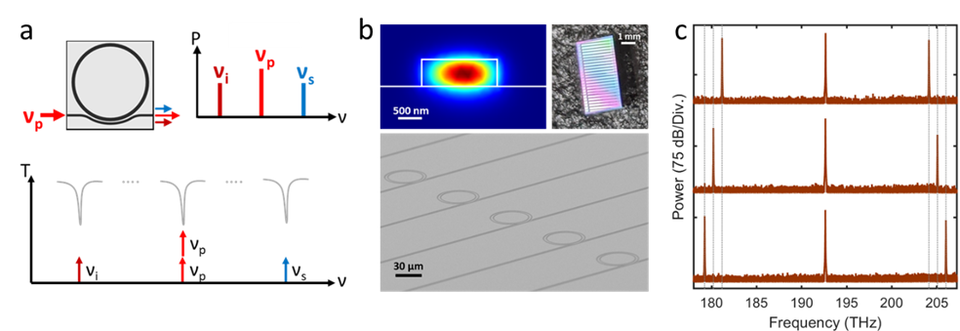Summary
Versatile laser sources enable much of modern science, and many emerging applications require coherent sources that are unavailable or underdeveloped. Nonlinear optics leverages light-matter interactions to provide access to arbitrary spectral regimes by laser-wavelength conversion, often in complex and expensive bulk systems. However, integrated photonics provide a powerful tool for broadly reconfigurable and unparalleled nonlinearity at the chip-scale, offering an ideal platform for compact and scalable laser-wavelength conversion. We explore novel dynamics in integrated nonlinear photonic devices for laser-wavelength conversion to enable new technological applications.
Description
Many sophisticated technologies, including detection and characterization of biological samples, quantum sensing of magnetic and electric fields, time standards based on atomic clocks, and precision metrology, demand versatile laser sources spanning a broad range of wavelengths. Nonlinear optics enables laser-wavelength conversion of robust, common, and commercially available laser sources in the near infrared wavelengths that are already widely used, eg. telecom bands. Typically, laser-wavelength conversion systems utilize large-scale, table-top optical systems with bulk nonlinear materials, which prohibit transportability and require complicated operation at great cost. Semiconductor lasers are affordable, compact, and offer both hybrid and heterogeneous integration opportunities with other photonic elements. We explore integrated nonlinear photonic laser wavelength conversion, compatible with semiconductor laser integration, to enable efficient, compact, and spectrally versatile chip-scale coherent sources for technologies of tomorrow.
Our project explores nonlinear dynamics in integrated nonlinear optical cavities, or microresonators, for laser-wavelength conversion. Figure panel a shows the concept of laser-wavelength conversion where a microresonator converts a single pump laser with frequency νp to two new frequencies, νs and νi, by optical parametric oscillation. The resonant frequencies of a microresonator provide optical field enhancement and dispersion engineering of the modes enable tunable phase-matching for efficient nonlinear wavelength conversion to target frequencies. To engineer the target converted frequencies with high conversion efficiency, we leverage geometric group-velocity dispersion as well as nanophotonic dispersion tuning of single microresonator modes. Figure panel b shows modelled resonant optical modes (top left) for dispersion engineering, a fabricated chip with > 100 microresonators (top right), and a zoomed in scanning electron microscope image (bottom) of several microresonators. Panel c demonstrates fine tuning of microresonator laser-wavelength conversion, where three stacked optical spectra show that we can convert a single pump frequency (center of the spectra) to three different pairs of output frequencies with the spacing of the microresonator free-spectral range. Our results highlight the power of microresonators for universal, efficient, and reconfigurable chip-scale laser-wavelength conversion exceeding an octave on a platform amendable to semiconductor laser integration.

Publications
[1] Black, Jennifer A., et al. "Group-velocity-dispersion engineering of tantala integrated photonics." Optics Letters 46.4 (2021): 817-820.
[2] Black, Jennifer A., et al. "Optical-parametric oscillation in photonic-crystal ring resonators." Optica 9.10 (2022): 1183-1189.
Major Accomplishments
- Innovated nanophotonic microresonators for universal phase-matching.
- Demonstrated microresonator laser conversion spanning visible to near-infrared wavelengths.
- Demonstrated 40% conversion efficiency, mW output power, and physical understanding of conversion efficiency in nonlinear wavelength converters.

